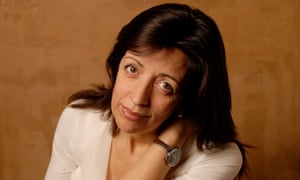It was supposed to be, says the writer Louise Doughty, a feminist indictment of the criminal justice system and of how women are still judged on their sexual conduct in a way that men aren’t. Instead – of course – it has become about the sex. Hot middle-aged sex. A middle-aged woman having hot middle‑aged sex with someone who is not her husband. The TV adaptation of Doughty’s novel Apple Tree Yard began last Sunday, with Emily Watson playing Yvonne Carmichael, a successful geneticist – plus wife and mother to grown-up children – who finds herself with a handsome stranger in a broom cupboard, deep beneath the House of Commons, where she has just been giving evidence before a select committee.
The Observer called it “groundbreaking”, the Spectator noted that midlife crisis novels were “traditionally a male form”. Doughty finds the fuss a bit bewildering. “I honestly didn’t believe I was doing anything that radical when I wrote the book,” she says. “In retrospect, it makes me sound really naive, but as a middle-aged woman who occasionally has sex, I really didn’t think it was big news, and neither did it feel like big news to any of my friends the same age.”
We have seen endless depictions of the male midlife crisis, but very few where a woman derails her previously comfortable life. “I think it’s nonsense that the midlife crisis is the preserve of men,” says Doughty. “I think there are lots of reasons why it doesn’t get talked about so openly by women. I think a lot of women prioritise protecting their families in a way that men maybe don’t. And also, for middle-aged women, it’s very common to still have a huge amount of caring duties. Even if your children are teenage, that doesn’t mean you haven’t still got a lot to do. Quite often you might also have elderly parents.”
So, it seems that there isn’t much time for the indulgence of a midlife crisis, regardless of whether it includes an affair or not. Perhaps women’s midlife crises happen more internally? “I think they do,” says Doughty. “I think they happen externally as well, but I think quite often for women there is a crisis of identity in a more internal way.”
Doughty also points to the changing roles of mothers, as their children grow up.“Once that self-identification starts to fall away, you can end up reassessing who you are and what you want,” she says. “I think that back in the days when women were more likely to be full-time housewives and mothers, once that role had ended there was a sense of the nest being empty. I think one of the bonuses of keeping your career going throughout child-rearing is that you still have something there.
“I wouldn’t want to over-emphasise a crisis of confidence, I think actually a lot of women my age are more confident than we’ve ever been. If you asked me to swap my 53-year-old self with my 23-year-old self, I would tell you to take a running jump. I’m so much happier now. There’s a line very early on in the book where Yvonne says, ‘Self-awareness, it’s our consolation prize,’ and that was very personal to me – I love knowing who I am and what I want. I think it’s something society forgets in its obsessive portrayal of young women as attractive. What you actually know, if you’ve been a young woman yourself, is that often behind the physical attractiveness lies a huge amount of insecurity and worry.”
Although the modern idea of a particular kind of middle-age malaise goes back to Freud and Jung, the term “midlife crisis” was coined in a 1965 paper by Elliot Jaques, a Canadian psychoanalyst, who described how people entering middle age are confronted with the limitations of their life and their own mortality. Middle age, writes the journalist Miranda Sawyer in Out of Time, her book about making peace with her own age, is full of “money problems, of work responsibilities and looming insecurities, of boredom and frustration and a lack of self-realisation, of caring for those younger and older than ourselves, of diminishing fitness, energy and relevance”. Divorce rates are highest among men aged 45 to 49, and for women between 40 and 44. The highest rate of suicide is among men aged 45 to 49. While suicide is less common in women, the age range at which it peaks is 50 to 54. The midlife crisis has become a joke, Sawyer writes, but it “is only easy and wink-wink-hilarious to those who are not in middle age”.

“For women there’s an awful lot around loss,” says the writer Kate Figes, 59, who has written several books about family life. “Loss of youth, possible dreams, even the future, if you feel your life is about to come to an end. For women I think there is also a sense of invisibility that can enter into it, because appearance – youthful sexuality – seems to be what people value most in women. A lot of women feel suddenly invisible. You no longer matter, you don’t turn heads in the street. One [of the women I interviewed] said, ‘I used to really care about how I looked, now I could put a paper bag on my head, walk out and nobody would even notice.’ So even though that may seem trivial to feminists, it’s actually very important for some women in terms of their sense of self.”
Young men, Figes argues, grow up believing that they get more physically attractive as they get older.
It can be dismaying if, as a woman, all your life you have listened to society’s message that you will be fine as long as you are nice, work hard, do what you are told – only to arrive at middle-age and realise it may have been largely for nothing. Figes agrees. “The positive way that I’ve found, and I think a lot of other women find, is to think, ‘I don’t care any more what anybody else thinks. I will say what I like, I don’t need to be nice.’ There is a sense that losing all those previously quintessential notions of femininity is a liberation.”
The clinical psychologist Linda Blair doesn’t like the word “crisis” at all. It has been 40 years, she points out, since Gail Sheehy wrote Passages, her influential book about life stages. “She talks about the different ‘passages’ that women go through and I think that’s a more appropriate term,” Blair says. “At different stages in our lives, we have different priorities and when those priorities need to change we experience a period of reforming.”
Many women Blair has seen in the course of her work have a sense of loss, but more than that, she says, they have a sense of uselessness. Their children, if they had them, might have left home, or they are feeling sidelined in their work. “‘I’m redundant’ – that’s the main thing I hear. ‘I’m no longer useful.’ Which is a shame, to be defined as no longer useful to others,” she says.
But, for Blair, a crisis – if we insist on calling it that – can be “very exciting, it can make you feel young, revitalised. It’s not what happens to us, I’ve found in 40 years of clinical work, it’s how we see it.”
A crisis is not an inevitable, or even a normal part of midlife, says Margie Lachman, director of the Lifespan Developmental Psychology Laboratory at Brandeis University in Massachusetts. “People have crises at other ages, and it is not more likely at midlife.” It may, she adds, be better described as a “turning point or midpoint check-up. The middle of life is a natural time for reflection on one’s life: how is it going? Is this all there is? Do I want to make changes? When the changes are big or seem sudden, often people characterise it as a midlife crisis.” But change, she adds, “can be a good thing”.
There has not been much research on the differences in how men and women go through a midlife crisis, but one study in 2000 by Elaine Wethington, a sociology professor at Cornell University in New York State, found that the phenomenon was actually more common in women, experienced by 26.3% of women and 25.4% of men. “Their description of the crisis was not that different,” says Lachman. “In a study I did in 1994, the main difference was that women focused more on physical and health changes. Wethington found that men were more likely to tie a crisis to disappointment in their career or job.”

However, there is, says Andrew Oswald, professor of economics and behavioural science at Warwick University, “overwhelming evidence that there is a midlife low. Would we call it a crisis? It would depend on your definition but there’s a very pronounced drop in mental wellbeing from about the early 20s down to the mid- to late 40s, and then a rise up. This is often described as looking like a U-shape. At the moment in Britain, say, the happiest people in the country are in their mid-70s.”
Is there a difference between men and women? This is the curious thing, Oswald says. He would have expected to see one – because of different traditional family roles, different ageing patterns, women’s hormonal changes during the menopause – but “the evidence suggests very little difference in the mental wellbeing through life between men and women”. Feelings of midlife crisis do not appear to be related to the stresses of having children, say, because people who do not become parents also bottom out. They also affect both educated and uneducated people. “It appears to be a very deep phenomenon,” adds Oswald, “one of the great social science puzzles.”
According to Oswald, scientists used to think that midlife crisis was connected to commonly accepted factors – facing up to your limitations, accepting that you’re never going to win a Nobel prize, play for Arsenal or be in a stadium-touring rock band. “But recently a group of us, [working] with primatologists, have shown the same U shape in chimpanzees and orangutans. Although that needs to be checked by other researchers, it raises the possibility that this is not a social science phenomenon, but a natural science phenomenon.”
Oswald believes that as we get older, the joy of novelty and youthful energy naturally decline. The question is, what causes the upward climb out of the low point? “How can people be getting happier in their 50s, 60s and 70s, when you would think that the prime of life was earlier?” It may be, he says, that we have learned to regret less or that wisdom is the pay-off for slowing down. I suppose that’s something to look forward to, if you’re in the grip of a midlife crisis – the fact that you will probably grow out of it.
Women on the verge of a midlife crisis
Hiç yorum yok:
Yorum Gönder